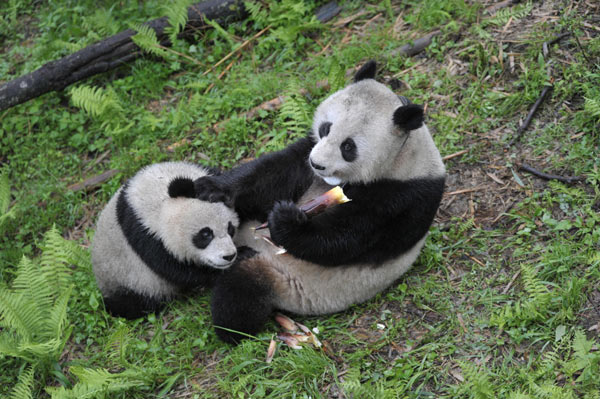Pandas set to take a walk on the wild side
Updated: 2012-06-08 08:07
By Jiang Xueqing and Huang Zhiling (China Daily)
|
|||||||||||
 |
|
Tao Tao (left), tries to get close to his mother Cao Cao in their semi-wild environment. Provided to China Daily |
On Feb 20 last year the researchers moved Tao Tao and his mother to a larger area, higher up the mountain. The area covers 40,000 sq m and is at an altitude of 2,000 to 2,100 meters above sea level. More than 10 wild pandas live on the outskirts of the training zone, which has plenty of umbrella bamboo, one of the most common varieties of the plant in Wolong. The environment is almost exactly the same as the pandas' natural habitat in the woods.
To prevent Tao Tao and Cao Cao from leaving the training area, they are enclosed by a 2.5-meter-tall fence. The scientists installed 55 cameras, both along the fence and inside the training area, to monitor the pandas. They also use binoculars to conduct long-range observation. Pandas are solitary and sedentary by nature and most of the time Tao Tao rests in the trees, only returning to his mother when he is hungry.
The cameras do not always work effectively and can barely detect the pandas when thick leaves cast their shadows across the fields, so researchers fitted Cao Cao with a GPS collar, enabling them to pinpoint her position and sphere of activity. The collar receives satellite signals that record the panda's longitude and altitude at any given moment and allows the researchers to download data from a distance of approximately 500 meters, although sometimes the thick foliage means that they have to approach as close as 100 meters.
The scientists now plan to make a model leopard, cover its body with excrement and urine collected from the zoo and record leopard roars. Eventually, the model will be placed inside the living area and a researcher will hide in a camouflaged watchtower. When Tao Tao passes close to the model, the researcher will activate a remote control to make the fake leopard roar and then observe Tao Tao's reaction. Using this technique, they hope to scare the cub and teach him how to identify and avoid natural enemies.
"As researchers, we are most worried about whether he can make it in the wild," said Zhang, the director of the center. Those concerns were especially acute at the beginning of the training period. Around 10 days after Tao Tao was born, Wolong was battered by a heavy two-day rainstorm. Everyone at the center was wracked with anxiety and a heated debate ensued as the researchers argued over whether to take the cub back to the center.
In the end, Zhang decided to take a risk. "We have to clench our teeth to surmount this barrier," he said. "If we take him back now, we'll have to take him back next time a similar problem crops up. So we have to take a brave step. Even if he dies, he'll be making a sacrifice for the salvation of his own species." To the relief of all the researchers, Tao Tao came through the rainstorm unscathed.
Concerns were again aroused during a heavy snowstorm in February 2011. Some parts of the training area, including the bamboo plantations, were buried in snow a meter deep. At the time, Tao Tao had just learned to walk and the researchers were afraid he would perish in the severe cold. However, their concerns were proved unfounded when they discovered that Cao Cao had trodden a path in the snow so that Tao Tao could follow in her footsteps. Later, the mother protected her offspring by driving a mask palm civet out of their living area.
"Now we have learned the lessons and realize that panda cubs must be steeled through bad weather and tough environment. It's the only way they will learn to adapt to this habitat," said Zhang.
After nearly two years of training, Tao Tao exhibits few differences to wild pandas in terms of food-base selection, searching out sources of water, orientation, evasion of enemies, and social communication, according to Zhang.
On May 3, Tao Tao and his mother were moved to a 240,000-sq-m area higher up in the mountain. By the time the pandas left, the cub already weighed 36 kg. Now, until October, the training schedule will focus on identifying natural enemies and friendly animals. The researchers also plan to buy some wild boar and goats and introduce them into the training area. They will also transfer a small number of pandas to Wolong from Ya'an so that Tao Tao can develop social connections and understand his place within the panda community.
"Our next step will be to form a standardized procedure for wilderness-survival training and establish a training plan with an annual target number," said Zhang. "That way we'll have a steady flow of pandas that fit the criteria to be released into small wild groups, integrate with the local community and breed. After years of hard work, we will finally achieve our goal of protecting the wild pandas, increasing their population and preserving their genetic diversity."
Contact the reporter at jiangxueqing@chinadaily.com.cn
Today's Top News
President Xi confident in recovery from quake
H7N9 update: 104 cases, 21 deaths
Telecom workers restore links
Coal mine blast kills 18 in Jilin
Intl scholarship puts China on the map
More bird flu patients discharged
Gold loses sheen, but still a safe bet
US 'turns blind eye to human rights'
Hot Topics
Lunar probe , China growth forecasts, Emission rules get tougher, China seen through 'colored lens', International board,
Editor's Picks

|

|

|

|

|

|





